
The Legend of Zelda: Ocarina of Time was a watershed moment for video games. Three-dimensional games were becoming the new standard and game designers were still trying to figure out things we take for granted; like controls or how the camera functions. Most 3D games were stages connected by menus and hardly any of them tried to convey the sense of a greater world because you couldn’t.
To build a 3D believable world and have a narrative to drive the gameplay forward was extremely ambitious in 1998. While Nintendo was very successful with The Legend of Zelda: Ocarina of Time back then and was adored by everyone; what is so impressive about it is how well it holds up almost a quarter century later.
Making something like The Legend of Zelda: Ocarina of Time in the 90s was like trying to hit a moving bullet with another bullet. It probably took a ton of tries and an unbelievably large amount of trial and error while developing. Miraculously, Nintendo got it right the first time and until Breath of the Wild, Ocarina of Time was the model for all 3D Zelda games. How’d they do it? Find out in The Legend of Zelda: Ocarina of Time review!
The Legend of Zelda: Ocarina of Time
Developer: Nintendo
Publisher: Nintendo
Platforms: Nintendo 3DS (as The Legend of Zelda: Ocarina of Time 3D), Nintendo Wii (via Virtual Console), Nintendo Wii U (via Virtual Console), Nintendo Gamecube, Nintendo Switch (via NSO+), Nintendo 64 (reviewed)
Release Date: November 23, 1998, (3DS ver.: June 19, 2011)
Players: 1
Price: n/a
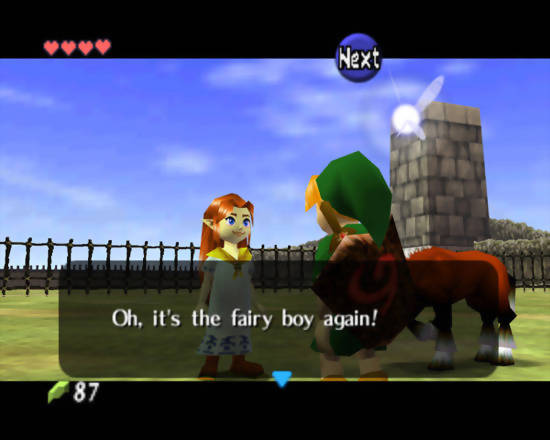
What hasn’t been said about The Legend of Zelda: Ocarina of Time? It is one of the most replayed Nintendo 64 games, available on virtually every console Nintendo produced since its release in 1998. When it came out, it struck a chord with gamers because of its impressive and detailed 3D world while drawing them in with a familiar story.
Most Zelda games follow the structure of Link having to acquire plot coupons in dungeons, which leads to earning the Master Sword. After acquiring the sword, there is some kind of world-altering gimmick like the Dark World, shrinking to the size of an ant, or the Twilight Realm. This mechanic will tie into the next set of dungeons and tools which climaxes with the final boss, usually Ganon.
Ocarina of Time is no different yet still proves to be one of the best-executed examples in the franchise. It has a simple but effective story that works thanks to how well it’s told. Link begins as a child and like a Hobbit being forced out of the Shire due to a frightful destiny he can’t comprehend, he embarks on an epic quest. He is a brave kid who accepts the call of the Godesses without question.
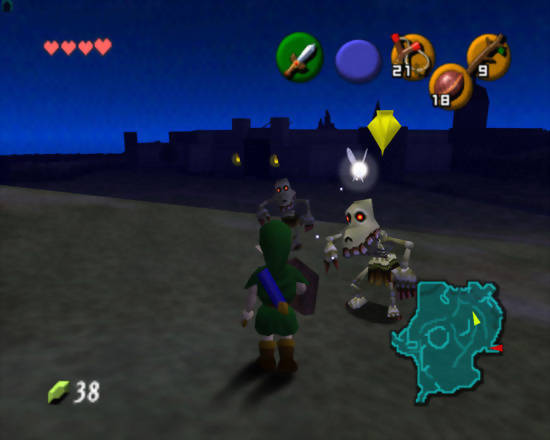
As Link’s journey unfolds, he will meet many characters. For such an old game, Ocarina of Time is packed with unique NPCs with mini story arcs peppered throughout the world. Every single one of them is given a bespoke design and personality. In some cases, characters get much older iterations of themselves because Ocarina of Time has a seven-year time travel mechanic.
By the time young Link completes the first three dungeons, he will earn the master sword. The problem is that when he pulls it out from the pedestal at the Temple of Time, he is shunted seven years into the future. It’s a profound metaphor for growing up and taking responsibility.
The world around Link changes, becoming darker and bleaker. Ganon has won during the seven years Link picks up the sword. Experiencing this as an adult gamer, this hits harder than it did when played as a child. It beautifully illustrates the feeling of the loss of innocence and how the passage of time can slip by without realizing it. Seven years go by in a blink and you are left wondering, “Where did the time go?”.

Was Hyrule always a dark and bleak place but Link’s innocence made him see it optimistically? Going back seven years as child Link makes you look at the place differently. There is a weighty and cathartic feeling of nostalgia that overwhelms. You can’t wistfully dwell on the past anymore. Ganon will take over and Link has responsibilities now.
Ocarina of Time is steeped in nostalgia. Not just because it’s an old game, but because it’s a game about nostalgia. There is a danger of refusing to grow up and rejecting responsibility, yet Ocarina of Time is also profound enough to recognize the importance of nostalgia since Link can go back as a child to make a change for himself as an adult.
Ocarina of Time’s emotional core is that it’s ok to entertain nostalgia. It can help us get through ordeals, but always be ready to face the present and what comes next. It’s a powerful message that strongly resonates with the human condition. Was this Nintendo’s intent when making it? Absolutely.
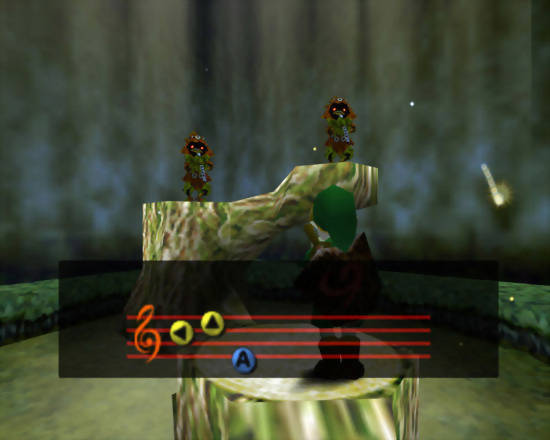
There are multiple allusions to J.M. Barrie’s Peter Pan and even Steven Spielberg’s 1991 film, Hook. Apart from the visual cues like green tunics, fairy companions, and lost boys/Kokiri; the stories explore the nature of coming-of-age and the loss of innocence.
The similarities imply a lot of thought was put into Ocarina of Time‘s themes. Nintendo games don’t always exhibit this level of care in their games’ narratives, nor do they always try to have something profound to say, yet they hit it out of the park effortlessly in this game.
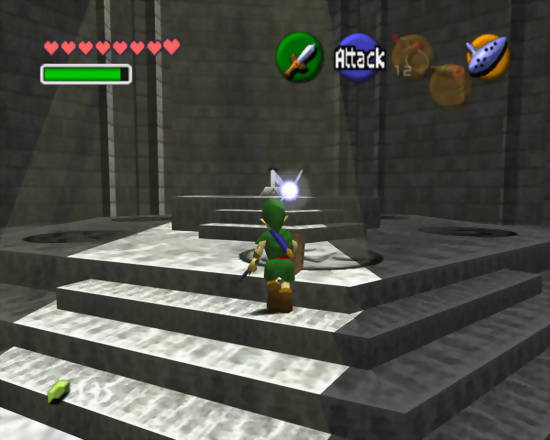
There is a lot to see and do while exploring the two distinct eras of Hyrule. Every area has some importance or ties into side content. It may seem quaint by today’s standards but this was one of the earliest examples of a 3D epic adventure and its scope still rivals most games today.
Like in Link to the Past, Link will discover several tools to aid him in his quest to save Hyrule. Some will be more useful than others like the bombs or hookshot, and some will also be exclusive to Link depending on how old he is. Some items are universal like bombs, but others are questionable.
Some of the logic behind what weapon he can and can’t use depending on his age doesn’t always make sense. Child Link not using the hammer makes sense because it’s too heavy, but not being able to use the hookshot is dumb. Adult Link can’t use deku nuts, sticks, or the boomerang. Why he can’t use the boomerang has never made any sense at all.
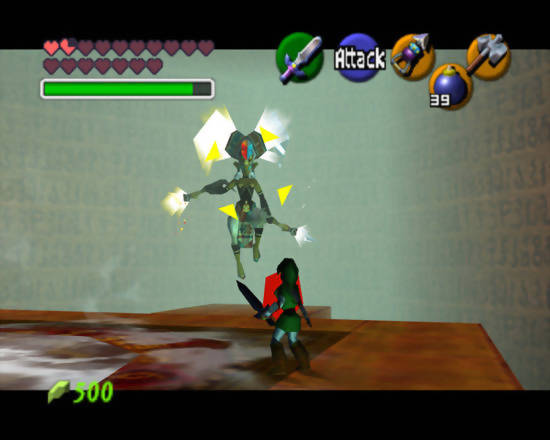
Other questionable design choices that have never made sense in Ocarina of Time are the arbitrary caps on items and rupees. The idea was to create a sense of progression but the limits only added busy work to take on some side quest to fix a created problem.
Rupees are especially poorly handled and have severe limits early on for no reason. Tons of money gets wasted because Link can barely hold any and the sad part is that there is hardly any use for currency apart from entrance fees for mini-games or to fulfill a few side quests.
Rupees have always been an afterthought in Zelda games. It wasn’t until Breath of the Wild and Tears of the Kingdom that there was practical use for money. Amusingly, Zelda games have abandoned the concept of upgradeable wallets around A Link Between Worlds… probably because they were a stupid idea.
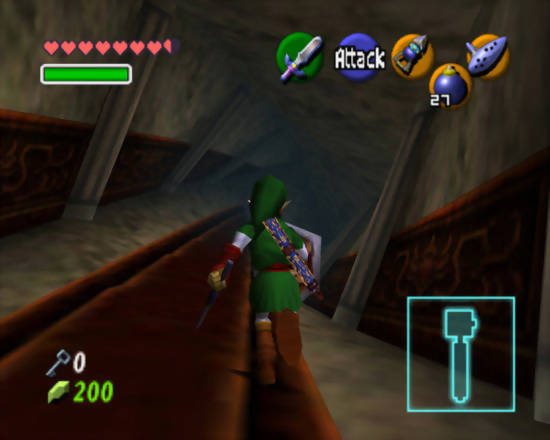
The layout and flow of areas are logical and impressive in their verticality. It’s a dense place full of platforms and puzzles and rooms that change in mysterious ways, adding intrigue. The dungeons are a highlight and constantly introduce new gimmicks and puzzles that feel like something out of an Indiana Jones movie.
Exploring Hyrule is fun so long as Link is in the main areas. Every region is connected by the Hyrule field, a large expanse where Lon Lon Ranch sits in the center. The first time walking out into the Hyrule field it’s amazing and creates a sense that you have a whole world at your fingertips. Then the reality of it hits and the Hyrule field becomes tedious.
Child Link can’t run as fast as adult Link and can’t ride a horse. Expect to dodge roll to pick up speed through this area. Getting through the field quickly becomes necessary since Ocarina of Time has a day and night cycle and every area changes depending if it’s night or day. What’s worse is that the field doesn’t have much in it.
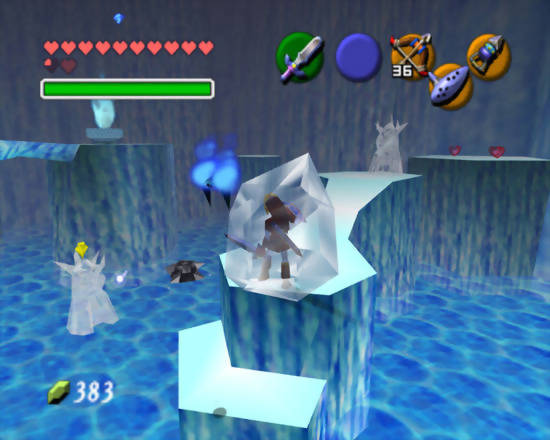
The other areas are so much more interesting. Lake Hylia is a wonderfully designed location and is home to a cheeky fishing mini-game and one of the most infamous dungeons in video game history.
The difficulty of the Water Temple has been greatly exaggerated but it is a pain. The problem is having to constantly pause and unpause the game to equip and unequip the iron boots to make Link sink or float. This is already a huge hassle when playing normally since Link will need to switch out various tools.
In the Water Temple, this problem was such a nuisance that when Ocarina of Time was remade for the 3DS, the iron boots became a mappable tool. The 3DS remake’s second screen enhances the inventory UI and removes the need to pause the game at all, keeping the action flowing fluently. It is one of the few legitimate improvements in the remake.
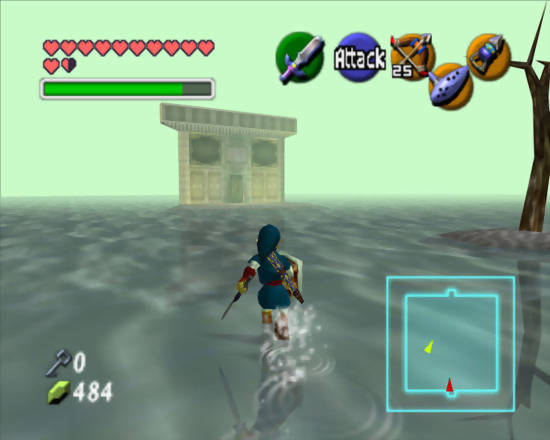
The atmosphere in Ocarina of Time is effective despite the crude textures and simplistic 3D models. The hypnotic music and signature Nintendo 64 grain and fog go a long way in giving the visuals their identity. Some areas look downright surreal and the lack of discipline in the art leads to some bizarre imagery, like the Great Fairy Fountains or the smudgy prerendered backgrounds.
The early attempts at lighting resulted in impressively moody lighting. The future is grungy as hell and the Forest Temple feels like some kind of Twilight Zone-esque purgatory. For such an early attempt at realizing a 3D world, the visuals still impress. Everything is readable and makes sense.
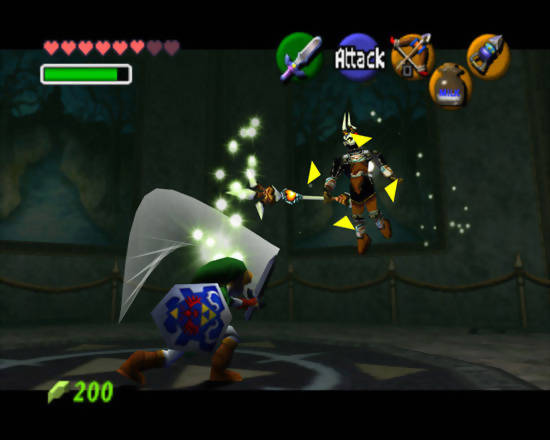
The combat is the least interesting aspect of Ocarina of Time. Link’s swordplay and weapons are rudimentary but effective. Sometimes too effective since he can attack almost as fast as players can tap the button while crouching.
Link has more moves than he will ever need. It’s shocking how much he can do and how useless most of it is. His spin attack is mostly used for cutting grass. There is almost no situation where he will ever need to attack an enemy with it.
For the most part, Link’s battle mechanics are the same as they have always been. He can target, block with his shield, circle-strafe, and perform a variety of slashes. Using tools like bombs or the hammer can make a difference, but it’s less reliable as slashing or shooting goes with a slingshot or arrows. It’s a system that Zelda games have been relying on to this day in modern 3D entries.
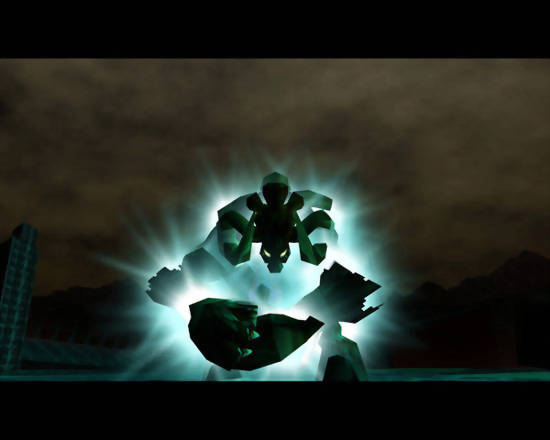
Ocarina of Time‘s gameplay holds up for such an early 3D game. Some aspects are weird like the lack of camera control and using Z-targeting to center the camera behind Link or the annoying item menu. These are small quibbles in a game with huge ambitions that changed the landscape of video games when it came out.
The older Ocarina of Time gets, it only becomes more relevant. Its themes resonate through a classic story of good versus evil and a weighty ending that carries tragic implications for anyone who has played the later entries in the franchise. It’s a tale as old as time itself and still engrosses despite its age.
The Legend of Zelda: Ocarina of Time was reviewed on Nintendo 64 using a copy purchased by Niche Gamer. You can find additional information about Niche Gamer’s review/ethics policy here. The Legend of Zelda: Ocarina of Time is now available for Nintendo Switch (via NSO+), Nintendo 64, Nintendo Gamecube, and a remake on Nintendo 3DS.